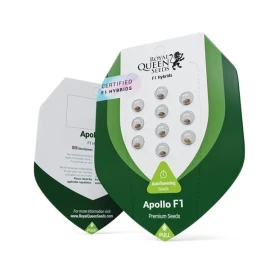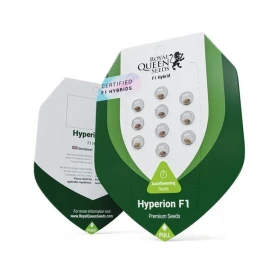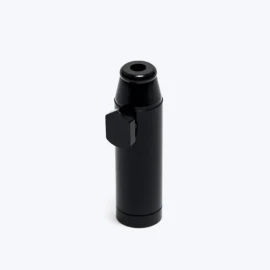Hyperion F1
12,00 €
A tall, high‑THC F1 autoflower from Royal Queen Seeds — easy to grow, uniform, XXL yields and resin-rich.
Key Specifications
| Genetics: | Amnesia × Lemon × Sin Tra Bajo Auto (F1 hybrid) |
| Total Cycle: | 80–85 days seed to harvest; 55 days flowering |
| Height: | 60–90+ cm (one of the tallest autoflowers available) |
| Yield: | XXL — commonly exceeds 500 g/m² indoors |
| Primary Terpenes: | Myrcene, ocimene, farnesene, caryophyllene, humulene |
| Aroma Profile: | Pine, spice, earth, citrus, pepper |
| Difficulty Level: | Easy — perfect for beginners and commercial cultivation |
| Ideal For: | Home growers (first-timers to advanced), micro-growers, commercial operations seeking consistent autoflower yields |
Understanding F1 Hybrid Cannabis
F1 hybrids represent the first generation offspring from crossing two genetically distinct parent lines. In cannabis cultivation, this creates “hybrid vigor” — a phenomenon where the offspring displays enhanced characteristics compared to either parent strain.
True F1 cannabis hybrids offer several advantages that make them particularly valuable for both novice and experienced growers. The genetic uniformity means every seed produces remarkably similar plants in terms of height, flowering time, and yield potential. This predictability eliminates much of the guesswork in planning grow spaces and harvest schedules.
Disease resistance naturally increases in F1 generations, reducing the likelihood of common cannabis ailments. The enhanced vigor typically translates to faster growth rates, increased resin production, and superior yield potential compared to traditional breeding approaches.
When autoflowering genetics combine with F1 breeding, growers benefit from both rapid harvest cycles and exceptional predictability. This combination appeals especially to commercial operations requiring consistent crop timing and home growers seeking reliable results without extensive phenotype hunting.
Contrary to some misconceptions, F1 hybrids maintain full potency potential. Laboratory testing consistently shows that properly bred F1 cannabis can achieve THC levels matching or exceeding traditional varieties while offering superior growing characteristics.
Genetic Background & Lineage
The Hyperion F1 brings together three carefully selected parent varieties, each contributing distinct traits to create a superior autoflowering experience.
Amnesia provides the foundation for cerebral potency and complex terpene development. This legendary genetics contributes to the strain’s high THC potential and delivers the classic citrus and earthy undertones that define the aroma profile. Amnesia’s influence ensures strong psychoactive effects with pronounced euphoric qualities.
Lemon genetics enhance the citrus terpene expression while contributing to faster maturation and increased resin production. This parent adds brightness to the overall aroma and may influence the strain’s ability to finish within the 80-85 day timeline while maintaining dense trichome coverage.
Sin Tra Bajo Auto delivers the crucial autoflowering trait alongside structural resilience and adaptability. This parent ensures the strain maintains robust growth patterns while automatically transitioning to flowering regardless of light schedules. The autoflowering genetics also contribute to the strain’s disease resistance and environmental tolerance.
The resulting F1 combination produces plants with exceptional uniformity in height, timing, and resin production. Growers can expect tall, single-cola dominant plants with strong lateral branching and consistent pine-citrus-spice aromatics across all phenotypes. The genetic stability minimizes variation between plants, though minor differences in secondary terpene expression may still occur.
Growth Profile & Development Timeline
Hyperion F1 develops into notably tall autoflowers with distinctive architecture optimized for maximum yield potential. Plants typically display a prominent central cola with robust secondary branching, creating an ideal structure for both natural growth and light training techniques.
Complete Lifecycle Timeline
Germination Phase (2-7 days): Seeds demonstrate excellent germination rates with strong taproot development. Optimal germination occurs at 22-26°C with consistent moisture.
Seedling Stage (Week 1-2): Rapid early development with distinctive broad leaflets emerging. Plants establish strong root systems during this critical period.
Vegetative Growth (Weeks 3-6): Aggressive upward growth characterizes this phase as plants can gain 10-15cm weekly. Lateral branching develops simultaneously, creating the foundation for multiple flowering sites.
Pre-flowering Transition (Week 6-7): Automatic flowering initiation begins regardless of light schedule. Plants may experience a final growth spurt during early flower development.
Flowering Period (Weeks 7-13): Approximately 55 days of dedicated flower development. Dense, resinous buds form along all branches with peak trichome production occurring in the final weeks.
Harvest Window (Days 80-85): Trichomes transition from clear to milky, indicating optimal harvest timing for maximum potency and yield.
Environmental Adaptability
Indoor cultivation suits Hyperion F1 exceptionally well, particularly in grow tents ranging from 80x80cm to larger commercial spaces. The predictable height makes canopy planning straightforward, though growers should account for potential 90cm+ heights in optimal conditions.
Outdoor cultivation succeeds in temperate and continental climates with warm summers. The strain’s resilience handles moderate temperature fluctuations while maintaining consistent development timing.
For micro-grows and limited vertical spaces, early low-stress training becomes essential to manage the natural tall tendency. The strain responds well to gentle bending and tying techniques that redirect growth horizontally.
Yield Potential & Resin Production
Hyperion F1 consistently delivers exceptional yields that justify its XXL classification. Indoor growers regularly achieve 500+ g/m² under optimized conditions, with experienced cultivators reporting yields approaching 600-700 g/m² in well-managed setups.
Individual plant yields vary based on growing conditions, but single plants commonly produce 50-100g dried flower in 60x60cm spaces. Larger containers and optimal lighting can push individual plant yields significantly higher.
The resin production stands as one of Hyperion F1’s most impressive characteristics. Dense trichome coverage extends from primary buds to secondary flowering sites and even sugar leaves. This abundant resin makes the strain exceptional for extraction purposes, whether processing into rosin, hash, or solvent-based concentrates.
Bud density achieves an optimal balance — firm enough for good bag appeal and storage characteristics while maintaining the airflow necessary to prevent mold issues. The combination of size and density creates visually striking flowers with substantial weight.
Maximizing Yield Potential
Proper lighting intensity proves crucial for achieving maximum yields. Indoor growers should provide 35-50 watts per square foot of quality LED lighting or equivalent PPFD levels of 600-900 μmol/m²/s during flowering.
Container size directly impacts yield potential. Minimum 11-liter containers allow proper root development, while 15-20 liter containers optimize yield potential for the strain’s large structure.
Gentle training techniques like low-stress training (LST) and selective defoliation increase light penetration to lower flowering sites without shocking autoflowering plants. Avoid aggressive techniques like topping or mainlining that may reduce overall yields.
Aroma, Flavor & Terpene Analysis
The sensory experience of Hyperion F1 reveals itself in layers, beginning with prominent pine and earth base notes complemented by bright citrus highlights and subtle peppery undertones. This complex profile develops throughout the growing cycle and continues evolving during the curing process.
Primary Terpene Profile
Myrcene dominates the terpene profile, contributing to the earthy, musky base notes while potentially enhancing the sedative aspects of the high. This terpene also influences the strain’s aromatic intensity and may affect the onset speed of effects.
Ocimene provides the fresh, citrusy top notes that brighten the overall aroma. This terpene contributes to the uplifting aspects of the experience and adds the herbaceous qualities that complement the earthier base.
Farnesene enhances the citrus expression while adding subtle woody undertones. This terpene may contribute to the strain’s complex layered aroma and potentially influences the duration of effects.
Caryophyllene delivers the distinctive peppery, spicy notes while potentially offering anti-inflammatory properties. This terpene adds complexity to the flavor profile and may contribute to the body effects.
Humulene rounds out the profile with woody, earthy notes while potentially providing appetite-suppressing qualities. This terpene enhances the overall depth of the aromatic experience.
Aroma Development
Fresh plants emit strong pine and citrus notes during vegetative growth, intensifying significantly during flowering. The complexity peaks during the final weeks when caryophyllene and humulene expression reaches maximum levels.
Post-harvest curing allows the terpene profile to mature and balance. Properly cured Hyperion F1 reveals the full spectrum of its aromatic potential, with initial pine giving way to layered citrus, spice, and earthy undertones.
Effects & Applications
Hyperion F1 delivers potent THC-forward effects that begin with pronounced cerebral euphoria before settling into relaxed physical sensations. The high typically starts with uplifting, creative energy that gradually transitions to a more balanced state combining mental clarity with physical comfort.
Psychoactive Profile
The initial onset brings clear-headed euphoria and enhanced focus, making it suitable for social situations or creative activities. Users often report increased appreciation for music, art, and social interaction during the first 1-2 hours.
As effects develop, physical relaxation becomes more prominent while maintaining mental clarity. This progression makes the strain versatile for both daytime and evening use, depending on individual tolerance and dosing.
The duration typically spans 2-4 hours with gradual tapering rather than abrupt cessation. The balanced nature prevents overwhelming sedation while providing substantial therapeutic potential.
Recommended Applications
Recreational Use: Ideal for social gatherings, creative projects, or relaxation after work. The balanced effects suit users seeking euphoria without excessive sedation.
Potential Therapeutic Applications: Many users report benefits for stress relief, mild pain management, and mood enhancement. Some find it helpful for promoting relaxation and sleep when consumed in higher amounts.
Important Note: Effects vary significantly between individuals. New users should start with minimal amounts and increase gradually. Those seeking therapeutic benefits should consult healthcare professionals for personalized guidance.
Comprehensive Growing Guide
Successfully cultivating Hyperion F1 requires attention to its specific needs while leveraging its naturally resilient characteristics. The following approach ensures optimal results for growers at all experience levels.
Essential Setup Requirements
Growing Medium: Quality soil provides the easiest approach for beginners, offering natural buffering and nutrient retention. Coco coir allows greater control over nutrition while maintaining good drainage. Hydroponic systems suit experienced growers seeking maximum yields.
Container Selection: Minimum 11-liter containers accommodate the root system, while 15-20 liter containers optimize yield potential. Fabric pots encourage healthy root development through air pruning.
Space Planning: Account for 60-90cm height plus container and lighting clearance. Minimum 80x80cm grow tents handle 1-4 plants effectively.
Lighting Strategy
Seedling Stage: Gentle lighting prevents stretching while encouraging healthy development. 100-200 PPFD with 18/6 light schedule works well.
Vegetative Growth: Increase intensity to 300-500 PPFD while maintaining 18/6 schedule. Quality LED lights should sit 30-45cm above canopy.
Flowering Period: Peak intensity of 600-900 PPFD maximizes bud development. Some growers prefer 20/4 schedules during flowering for increased daily light integral.
Light Distance Management: Monitor plants for light stress signs (leaf tacoing, bleaching) and adjust distance accordingly. Heat buildup requires adequate ventilation.
Nutrition & pH Management
Soil Growing: Start with quality pre-fertilized soil and supplement with gentle organic nutrients. Maintain pH between 6.0-6.8 for optimal nutrient uptake.
Coco/Hydro Growing: Begin with low EC levels (0.8-1.0) during seedling stage, gradually increasing to 1.2-1.6 EC during peak flowering. Maintain pH between 5.8-6.2.
Feeding Schedule: Autoflowers prefer consistent, moderate feeding rather than heavy nutrient doses. Begin feeding at 1/4 strength and increase based on plant response.
Common Nutrient Guidelines:
- Seedling: Light feeding, focus on root development
- Vegetative: Balanced NPK with slight nitrogen emphasis
- Early flowering: Transition to phosphorus-potassium focus
- Late flowering: Reduce nitrogen, maintain PK levels
Training & Canopy Management
Low-Stress Training (LST): Begin gentle bending and tying during week 3-4 to create horizontal growth and increase flowering sites. This technique suits autoflowers perfectly without causing stress-induced delays.
Selective Defoliation: Remove fan leaves blocking light to flowering sites during early flowering. Limit defoliation to essential leaves only, as autoflowers have less recovery time.
Support Systems: Install stakes or netting early to support the naturally tall structure and heavy buds that develop during flowering.
Avoid These Techniques: Heavy topping, mainlining, or aggressive pruning can reduce yields in autoflowers due to their fixed lifecycle timing.
Environmental Control
Temperature Management: Maintain 20-26°C during lights-on periods with 3-5°C reduction during lights-off. Higher temperatures may cause stretching and reduce trichome production.
Humidity Control: Keep 60-70% RH during vegetative growth, reducing to 40-55% during flowering to prevent bud rot in dense flowers.
Air Circulation: Provide gentle air movement across the canopy without direct wind stress. Exhaust fans should maintain fresh air exchange every 3-5 minutes.
CO2 Considerations: Sealed rooms with CO2 supplementation can boost yields, but proper environmental control becomes more critical.
Harvest & Post-Harvest
Harvest Timing: Monitor trichomes with magnification. Harvest when most trichomes appear milky white with 10-20% amber for balanced effects.
Flushing: Reduce nutrient levels during the final 1-2 weeks, providing only pH-adjusted water to improve final product quality.
Drying Process: Hang whole plants or branches in 18-21°C environment with 50-60% humidity for 7-14 days until small stems snap cleanly.
Curing Protocol: Transfer dried flowers to glass jars, filling 60-70% full. Store at 18-21°C with 58-62% humidity, opening jars daily for the first week, then less frequently over 2-8 weeks.
Advanced Cultivation Techniques
Experienced growers can optimize Hyperion F1 yields through advanced techniques that leverage the strain’s uniform characteristics and vigorous growth patterns.
Multi-Plant Canopy Planning
The uniform growth patterns of F1 genetics enable precise canopy planning across multiple plants. Calculate plant spacing based on expected branch spread (typically 30-40cm radius per plant) to optimize light distribution.
Stagger planting by 1-2 weeks to create perpetual harvest schedules. The consistent 80-85 day cycle allows for predictable planning and continuous production.
Commercial Growing Considerations
Batch Scheduling: The uniform flowering time enables synchronized harvests across large numbers of plants. Plan trimming and processing resources accordingly.
Automated Systems: The consistent nutrient requirements suit automated fertigation systems. Program feeding schedules based on the predictable growth phases.
Extraction Planning: High resin production makes Hyperion F1 excellent for commercial extraction. Plan harvest timing to coordinate with processing schedules.
Sea of Green (SOG) Optimization
The naturally vigorous growth and single-cola dominance make Hyperion F1 excellent for SOG setups. Use smaller containers (7-11 liters) with higher plant density (16-25 plants per m²) for rapid canopy fill.
Minimal training required in SOG setups — simply remove lower branching to focus energy on main colas. This approach maximizes space efficiency while maintaining quality.
Real Grower Results
Case Study 1: Micro Tent Setup
Setup: 60x60x120cm tent, 150W LED, 11L fabric pots, soil medium
Timeline: 82 days seed to harvest
Yield: 78g dried flower from single plant
Notes: Minimal training used, plant reached 75cm height. Excellent trichome coverage made trimming efficient. Grower noted strong pine aroma throughout flowering.
Case Study 2: Optimized Indoor Run
Setup: 120x120x200cm tent, 480W LED, 18L containers, coco medium
Timeline: 84 days total, harvest window of 3 days across 4 plants
Yield: 524g total (131g average per plant)
Notes: LST applied during weeks 3-5 created even canopy. Consistent feeding schedule with EC peaks at 1.4. All plants showed similar structure and timing.
Case Study 3: Outdoor Continental Climate
Setup: Single plant, 25L container, natural sunlight, soil medium
Timeline: 88 days due to cooler nighttime temperatures
Yield: 156g dried flower
Notes: Plant reached 95cm height with excellent lateral branching. Some late-season humidity challenges managed with strategic defoliation. Final product showed enhanced terpene complexity from temperature fluctuations.
Comparison With Other Autoflowers
Hyperion F1 distinguishes itself from traditional autoflowers through several key characteristics that appeal to different growing objectives.
Height Advantage: Most autoflowers remain compact (40-70cm), while Hyperion F1’s 60-90cm+ stature enables larger yields without requiring specialized techniques.
Genetic Uniformity: Traditional autoflower seeds may show significant phenotype variation. F1 breeding reduces this variability, creating more predictable results.
Yield Consistency: While other high-yielding autos might achieve similar peaks, Hyperion F1 delivers more consistent results across different growing conditions and skill levels.
Resin Production: The abundant trichome coverage exceeds many popular autoflowers, making it particularly valuable for extraction purposes.
Commercial Viability: The combination of uniformity, yield, and quality makes Hyperion F1 more suitable for commercial operations than most autoflowering varieties.
Frequently Asked Questions
Is Hyperion F1 truly an autoflower?
Yes, Hyperion F1 flowers automatically based on age rather than light schedule changes. Plants typically begin flowering around week 6-7 regardless of lighting conditions.
How long until I can harvest?
Expect 80-85 days from seed to harvest under optimal conditions. Cool temperatures or stress may extend this timeline by 5-10 days.
Will it really get as tall as claimed?
Most plants reach 60-80cm under normal conditions, with some exceeding 90cm in optimal setups. Height can be managed through early training techniques.
Are all seeds identical?
F1 genetics create high uniformity, but minor variations in secondary traits like terpene intensity may still occur. Primary characteristics (height, timing, yield) remain very consistent.
Can I top Hyperion F1?
While possible, topping is not recommended as it may reduce total yields. Low-stress training achieves better results without risking stress-related delays.
What yields should I expect in a small tent?
In 60x60cm spaces with adequate lighting, expect 50-80g per plant. Larger tents with optimal conditions can achieve 100-150g per plant.
Is it good for making concentrates?
Excellent for extractions due to high resin production and favorable terpene profile. Both solvent-based and rosin pressing yield quality results.
Does it have any unique growing challenges?
No strain-specific issues, but the tall structure requires adequate vertical space and may need support during heavy flowering. Standard autoflower principles apply.
Where can I find lab testing data?
Request current batch certificates from your seed supplier. Third-party testing provides the most reliable cannabinoid and terpene data.
Troubleshooting Common Issues
Excessive Stretching
Symptoms: Rapid vertical growth with long internodes
Causes: Insufficient light intensity or poor spectrum
Solutions: Increase light intensity, reduce light distance, ensure full spectrum LED coverage
Nutrient Deficiencies
Symptoms: Yellowing leaves, stunted growth, poor bud development
Causes: Incorrect pH, overfertilization causing lockout, inadequate nutrition
Solutions: Check and adjust pH, flush if overfed, provide balanced nutrition appropriate for growth stage
Bud Rot Risk
Symptoms: Brown spots on buds, musty odor, fluffy white growth
Causes: High humidity combined with dense bud structure and poor airflow
Solutions: Reduce humidity to 40-50%, increase air circulation, remove affected areas immediately
Low Yields
Symptoms: Small buds, limited branching, premature harvest
Causes: Insufficient lighting, container too small, excessive stress, poor environmental control
Solutions: Upgrade lighting to 35+ watts per square foot, use minimum 11L containers, maintain stable environment, avoid heavy training
Hermaphroditic Traits
Symptoms: Male flowers appearing on female plants
Causes: Environmental stress, light leaks during dark periods, genetic predisposition
Solutions: Eliminate stress sources, ensure complete darkness during rest periods, remove male flowers promptly
Laboratory Data & Quality Verification
Hyperion F1 consistently demonstrates high cannabinoid levels with THC typically ranging from 18-25% in optimal growing conditions. CBD levels remain low (typically <1%), creating the clear psychoactive profile characteristic of modern cannabis varieties.
Terpene analysis reveals the complex profile that defines the strain’s aromatic appeal. Myrcene levels often reach 0.5-1.2% of dry weight, while ocimene, farnesene, caryophyllene, and humulene each contribute 0.1-0.8% depending on growing conditions and curing protocols.
Quality verification through third-party testing ensures freedom from pesticides, mycotoxins, and heavy metals. Properly grown Hyperion F1 consistently passes safety screenings while maintaining high potency levels.
Growers should request current batch certificates when purchasing seeds to verify the specific characteristics of their genetics. Testing variability between growing conditions emphasizes the importance of proper cultivation techniques in achieving optimal results.
Legal Compliance & Safety Information
Age Restriction: Cannabis seeds are sold only to individuals meeting legal age requirements in their jurisdiction. Verify local laws before purchasing or germinating seeds.
Legal Jurisdiction Compliance: Seeds are intended only for customers in regions where cannabis cultivation is legally permitted. Research and comply with all local, state, and federal regulations.
Medical Disclaimer: Information provided is for educational purposes only and does not constitute medical advice. Consult qualified healthcare professionals for therapeutic applications.
Growing Responsibility: Cultivators assume full responsibility for compliance with local laws, safe growing practices, and proper security measures to prevent unauthorized access.
The information presented reflects general characteristics and growing guidelines. Individual results may vary based on growing conditions, techniques, and environmental factors. Success depends on proper application of cultivation principles and adherence to legal requirements.
Related Products
Frequently Asked Questions
Everything You Need to Know















